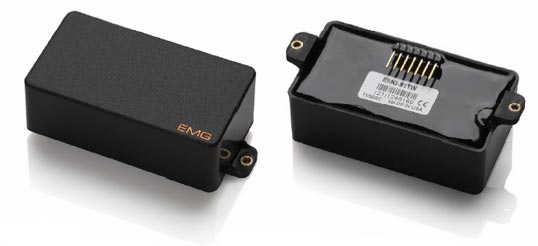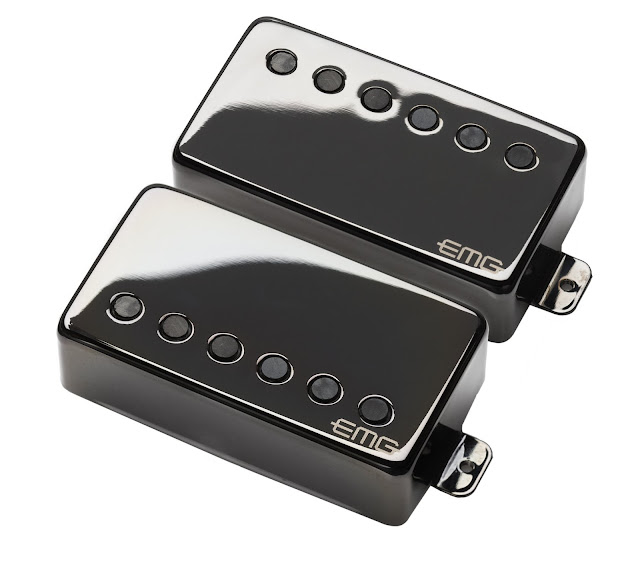ADJUSTING PASSIVE HUMBUCKERS
Adjusting for Balance

Balance in this case refers to consistent string-to-string volume.
Ideally, with a balanced pickup, one can strum all six (or seven or
eight) strings and hear each note ring out with even volume through an
amplifier. Balanced string-to-string output is good. It makes our chords
sound fuller, our runs and leads more consistent, and helps the guitar
respond more evenly, like a higher-quality instrument.
Some guitars happily exhibit this trait acoustically, but even those that don’t can be adjusted so that they do through an amp, and that’s really what matters, right?
String-to-string balance is manipulated via the screw poles in the
top of the pickup. Again, designs vary, but they all function about the
same.
• If the pickup has flat-head screw poles, we’ll need a flat-head screwdriver.
• If the pickup has Philips-head screw poles, we’ll need a Philips screwdriver.
• If the pickup has hex key poles, we’ll need a hex key of the appropriate size.
• If the pickup has two rows of screw
poles, or twice as many crammed into one row (I’m looking at you,
Carvin), we’ll need a little extra patience.
The screw poles are named so because they are screws; they are screws
because they’re meant to turn, and turning them is how we adjust the
string-to-string balance of the pickup. Kind of like putting on pants
before putting on shoes, I find it’s best to begin with this step so as
to avoid messing up other adjustments we will have already made by doing
it later.
So, plug in your guitar and turn them.
Tweak them just enough that the strings all sound like they’re
ringing out at the same volume when each one is plucked individually.
It’s fine to use a guitar amp to monitor this and trust your ears, but I
prefer to use something that gives me a visual readout of the string
volume (like an audio workstation or any other piece of equipment with a
dB meter) as I make adjustments. I pluck a string, note what the dB
meter reads, and adjust the screw pole until it matches the meter
readings of the rest of the strings. This way I ensure that my
adjustments are accurate and my results are not affected by any
compression inherent in a particular amplifier.

The
blue waveform on top was recorded prior to adjustment. Note how much
smaller the output differential (highlighted area) is on the green
waveform, which was recorded after adjustment.
If the screw poles in the pickup were already adjusted by someone
else or are all wonky for whatever reason, “reset” them by screwing them
all back to a position where they’re slightly higher than level with
the surface of the pickup bobbin. This way there’s plenty of room to
adjust up, but also a little bit of room to adjust down without sinking
the poles too far below the surface of the bobbin (which looks weird and
can collect gunk over time). The goal is to find a mean depth for all
the screw poles, so that none of them wind up too high or too low
relative to the function of the guitar when finished.
Adjusting for Output
Once
we’ve balanced the poles for string-to-string volume, we can adjust the
overall height of the pickup for the desired output level. Output
refers to the strength of the guitar’s signal from the pickups. More
output = a hotter signal. This typically equates to more volume in a
clean setup and more overdrive in a dirty one. Raising the pickup
increases the output and lowering the pickup decreases it.
There are other incremental tonal changes that accompany this
adjustment. These can range in intensity between different pickup
models, but generally speaking, a pickup will sound brighter and dirtier
closer to the strings and rounder, darker, and woodier further away
from the strings.
I find also that pickups set lower are more responsive to picking
dynamics. Whether this is a product of decreased median output and
hence, more headroom, or if the lower pickup position physically
provides them with a larger “window” through which can detect finer
detail in string velocity, I don’t know. Whatever. It works. Practical
knowledge FTW.
Additional Considerations
While 95% of what you need to worry about during pickup adjustment is
covered above, there are a few ancillary factors to be mindful of,
specifically: clearance, sustain, and pickup-to-pickup balance.

Note the grooves worn into the P-90 housing from string contact
Pickups can be raised up pretty close to the strings without actually
making contact while we’re testing out the adjustment, but actual
playing conditions do vary and we may find that palm mutes or heavy
picking causes the string to choke out some against the pickup. This is
decidedly… undesirable. It sounds bad and can cause the strings to wear
grooves into the tops of your pickups over time. If this happens, lower
that puppy down a hair to get it out of the way.

This
medium-output (9 kΩ) bridge pickup is nice and close to deliver a good
punch, but a higher-output pickup would probably need to be lowered to
prevent string-pull.
Passive pickups can also exert a small amount of magnetic pull on
electric guitar strings. If the pickup magnet is particularly strong or
set too near the strings, it can act as a dampening force on them,
reducing sustain, and in extreme cases, actually cause the strings to
sound out of tune. The latter is rare, and the former is usually an easy
fix, so if you find that your guitar seemed to “sing” more before you
adjusted the pickups, try lowering them down a little bit.

See the subtle emphasis on the bridge pickup in this picture? That’s known in the industry as “bad photography.”
The last thing to consider is the output ratio between bridge and
neck pickups. This presents something of a balancing act between getting
the pickup height just right for each of them so they sound their best
individually while keeping their output as complimentary as possible. I
find that I prefer a slightly hotter bridge pickup compared to the neck
pickup and adjust their height accordingly, but tastes differ on what
makes a good ratio between bridge and neck pickup output, so again,
trust your ears.
(Indonesian) THE POINT IS :
Pergunakan sekrup diatas pickup pasifmu hanya untuk "menyeimbangkan" sound output dari senar per senar. Apabila sound output/volume setiap senarnya dirasa sudah seimbang dan kamu masih belum mendapatkan output yang lebih HOT/besar baru gunakan 2 sekrup yang berasa disamping atas/bawah pickup pasifmu untuk menyesuaikannya dengan seleramu.
6 Sekrup diatas pickup = untuk balancing output level per senar,
2 Sekrup di samping = untuk menambah/mengurangi output level keseluruhan pickup.
Tapi ingat, apabila pickup terlalu dekat dengan senar, dapat menyebabkan senar menabrak permukaan pickup/noisey , mengurangi sustain serta dapat membuat senar menjadi out of tune.
BE A BALANCED GUITARIST !! :P



















